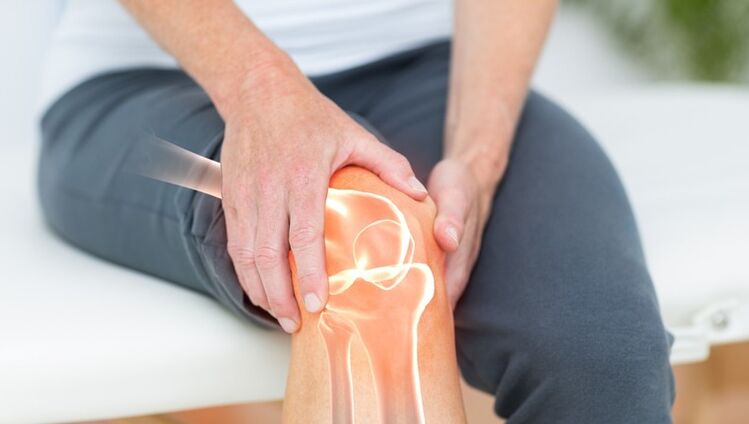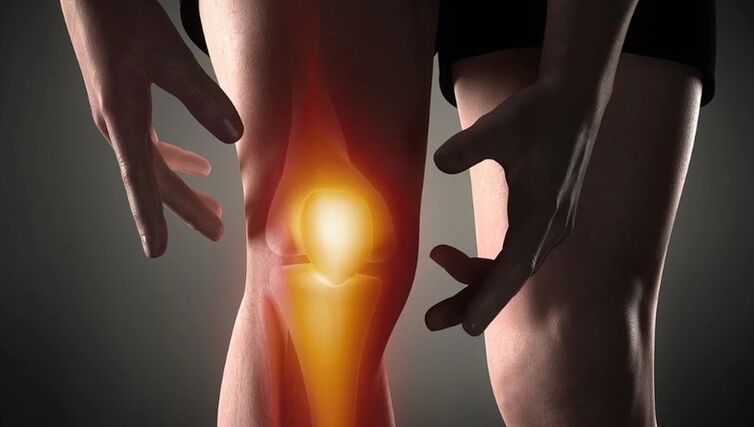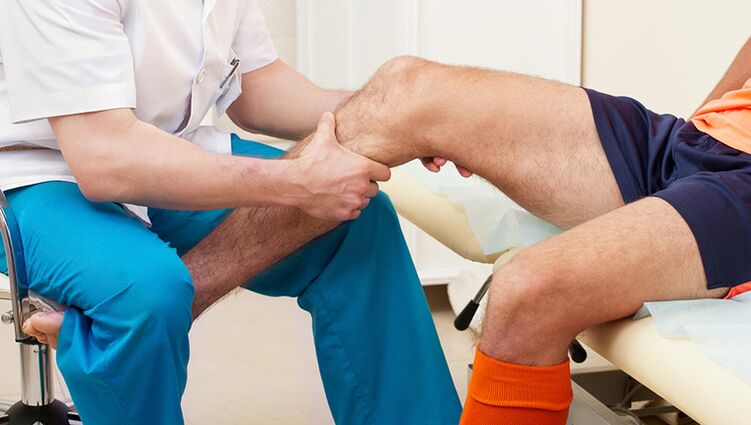The knee joint is one of the most complex joints in the human body.Due to systematic stress, every person experiences dull, aching or stabbing and sometimes unbearable joint pain at least once in their life.It can occur when walking and moving the knee and can also be a constant problem.The type of pain in the knee joint and the causes of its occurrence are very diverse.

Structure of the knee joint
As the largest joint element in the human body, the knee joint is constantly exposed to sports injuries.Bones, cartilage, tendons, ligaments, meniscus and periarticular capsules – when these parts are injured, they are sure to cause knee pain.
The composition of the bones of the knee joint includes:
- Shinbone (tibia).This is the main supporting bone that connects to the lower part of the femur.
- the thigh bone (femur), which is the longest and strongest bone and is connected to the kneecap and shinbone;
- the patella, which is located on the underside of the thigh.Together with the femur, it forms the patellofemoral joint.
The connection between the femur and kneecap contains cartilage that allows these bones to maintain a healthy state of motion relative to each other, thereby preventing friction and pain in the knee.
The muscles of the knee joint include the muscles of the back of the thigh and the quadriceps muscle:
- The muscle group of the posterior surface of the thigh consists of four heads located in its front part.These are the rectus femoris, the vastus lateralis, the vastus medialis and the vastus intermedius.They are attached to the joint with tendons.Contraction of the quadriceps muscle straightens the lower leg and straightens the leg.
- The muscle group of the posterior surface of the thigh consists of three muscles, the contraction of which contributes to the flexion of the lower leg.These are the biceps, semimembranosus and semitendinosus muscles.
There are two main types of cartilage in the knee joint:
- Hyaline cartilage provides less friction because it is strong and flexible.
- The medial and lateral menisci are cartilaginous structures that act as “airbags” to provide cushioning between the bones in contact.
The knee joint consists of ligaments in the form of fibers made up of connective tissue.
Ligaments connect bones together:
- The tibia and femur are connected by the anterior cruciate ligament.It prevents the tibia from moving forward relative to the femur.
- The job of the posterior cruciate ligament is to prevent backward movement of the tibia relative to the femur.
- The external collateral ligament is located on the outside of the knee.It connects the fibula and femur and helps limit force and stabilize the knee joint.
- The inner lower edge of the femur is connected to the upper inner edge of the tibia by the collateral medial ligament, which stabilizes the joint and prevents unwanted movement.
Tendons connect muscles to bones.
Tendons are divided into the following types:
- At the back of the knee joint are the tendons of the hamstring muscles.
- The quadriceps tendons are attached to the top of the socket.
- The lower portion of the kneecap is connected to the top of the shinbone via the hamstring tendon.
The type of pain depends on the location
Pathological changes in the joint directly depend on the location of the pain.Pain as an indicator signals complaints and changes in the joint.
Namely:
- with arthritis, acute bursitis, meniscus rupture, severe excruciating pain occurs;
- with initial bursitis and synovitis - tolerable but constant pain;
- Gonarthrosis and arthrosis are accompanied by pressing pain;
- in degenerative arthrosis with joint deformation - vibrating pain;
- with bone tuberculosis and damage to the sciatic nerve, the pain is acute;
- Injury to the menisci, osteoporosis, inflammation of the bursa are accompanied by stabbing pain in the knee joint;
- Inflammation in the tendon and muscle tissue of the joint causes cramping pain;
- If the nerve roots are damaged, stabbing pain occurs.
Causes of pain in the knee joint
Medical statistics show that knee pain syndrome is caused by an inflammatory process in the knee.
Sources can be very different:
- 50% of pain conditions are associated with osteoarthritis, in which the hyaline cartilage is slowly destroyed.Sometimes the disease is asymptomatic and only worsens in the second stage.Unpleasant sensations can occur due to the growth of osteophytes and their influence on the nerves in the joint.
- Often a joint can be affected by arthritis, both as an independent disease and as a complication in the form of rheumatism and osteoarthritis.Arthritis is characterized by severe pain, swelling, and redness of the knee.
- Pain can occur with osteochondritis when the articular cartilage becomes inflamed as a result of degenerative osteoarthritis or mechanical trauma.
- The result of obesity is often periarthritis, which affects tendons, muscles and sometimes the joint lining.The disease is accompanied by excruciating pain.
- Bursitis occurs when the synovial capsule becomes inflamed due to injury or complications from other diseases of the knee joint.
- In chondromatosis, nodules form in the area of the hyaline cartilage, which then spread throughout the entire joint.Soft tissues with a large number of nerve cells are pinched and pain occurs.
- With cellulite, pain can occur if foci of other concomitant diseases (purulent arthritis, soft tissue abscess) are located near the fatty tissue under the skin.
- Dermatitis involves damage to the epidermis caused by eczema, erysipelas, allergic reactions and psoriasis.
- Synovitis is characterized by damage to the joint capsule as a result of chronic pathological changes.This disease develops in elderly people over 55 years old.At a young age, the disease can occur due to serious injuries.
- Pain is caused by osteomelitis, which is characterized by bacterial inflammation of the bone marrow.The disease can arise from complications during operations or from open injuries.

What to do if your knee joint hurts a lot?
After the causes of joint pain have been identified, it is necessary to begin treating the pathology.The most effective treatment is medication, as conservative therapy can help with the development of destructive changes in the body.If you do not see a doctor in time, you will have to resort to surgical intervention.
Knee pain often begins suddenly and a person does not know how to behave in such a situation.If it is not possible to contact a specialist promptly, urgent measures must be taken to relieve pain and swelling.
Which activities help:
- it is necessary to stop any activity, lie down with a pillow under the knee;
- In case of swelling, you need to use cold compresses (ice, cold objects) 4-5 times a day for 15-20 minutes.
- If two days have passed after treatment and the pain has subsided significantly, you can start doing exercises to restore joint flexibility.A short massage (5-10 minutes) is possible;
- To combat pain after an impact on the knee, you need to wrap it loosely with an elastic bandage (or use a knee brace) to maintain the correct functioning of the joint parts.
- Even if you endure the pain for several weeks after the injury, you need to treat the injured limb with caution, move less, and avoid vigorous activity.
To relieve pain in the knee joint, you can proceed with conservative treatment.The most commonly recommended drugs by doctors are non-steroidal anti-inflammatory drugs in the form of gels, ointments and tablets.
Conservative treatment is often supplemented by physiotherapeutic procedures.Manual therapy is very effective, with the help of which you can heal ligament, meniscus and osteoarthritis damage in the initial stages.
In cases where conservative treatment of the knee joint is not possible, experts recommend surgical intervention.Torn ligaments, meniscus, fractures - such injuries are repaired with the help of serious operations.
diagnosis
Early diagnosis allows successful treatment of knee joint diseases and eliminates the risk of serious processes.An initial consultation with a therapist helps determine the direction of the examination and referral to a specialist.
Pain sensations are studied in different directions:
- In surgery.CT, MRI, ultrasound, fluoroscopy, blood tests for rheumatoid factor, puncture of the hyaline cartilage of the knee joint are used.
- In traumatology.The examination is carried out using X-rays, ultrasound, MRI and a liquid biopsy in the bursa.
- In rheumatology.General laboratory tests are carried out in the form of a blood test for the presence of rheumatoid protein, hematology and uric acid levels.DNA testing is used.
- In psychiatry and neurology.You can use ultrasound to diagnose pinched muscles and nerves.In the case of so-called somatic pain in patients with mental disorders, a special examination is prescribed to check for the presence of a mental illness.

Treatment of knee joint diseases
Folk remedies
After an accurate diagnosis, you can turn to conventional medicine and be sure to consult your doctor.It is impossible to completely cure diseases of the knee joint using traditional methods, but traditional medicine helps to relieve pain and inflammation, and can also serve as maintenance therapy.
Rubs and ointments are considered effective folk remedies:
- Egg yolk ointment.The yolk is ground together with a spoonful of turpentine and a tablespoon of apple cider vinegar.Helps relieve joint pain and inflammation;
- 300 g of horse chestnut seeds are crushed and added to a bottle of vodka.This mixture is infused for two weeks (it is necessary to shake the infusion alternately).
Used for rubbing before bedtime.Knee joints are also treated with compresses.
For this type of treatment, medicinal plants and vegetables are used:
- Thoroughly rinse 7-8 burdock leaves, wipe dry, fold and squeeze with a bowl of boiling water to release healing phytoncides.Then place the steamed leaves on a knee previously greased with vegetable oil, wrap it in cling film and cover it with gauze or a soft cloth.The compress is kept for several hours.
- Peel the raw potato tubers, grate them on a coarse grater and heat them a little in a water bath.Place the puree in a natural material bag.The bag is placed on the knee and left overnight.The treatment takes place within a week.Remember to prepare a new contents of the bag every day.
- To relieve pain and stop the inflammatory process in the knee, celandine is used.It is necessary to thoroughly soak the linen fabric with the plant sap, wrap it around the knee and cover it with foil.The compress should be kept for about 50 minutes, after which the knee should be treated with sunflower oil.The weekly procedure must be carried out three times with 10-day breaks.
Traditional medicine
Diseases of the knee joint often manifest themselves in the form of long-lasting pain, difficulty moving, swelling, deformation and inflammation of the knee.Arthritis, arthrosis and bursitis are characterized by inflammatory processes and swelling of the knee joint, often associated with an increase in body temperature.
Arthritis and arthrosis are treated with anti-inflammatory nonsteroidal drugs.The prerequisite for therapy is the normalization of metabolism and the removal of salts with the help of a number of drugs, as well as the establishment of an optimal acid-base balance.When treating arthritis and arthrosis, you must definitely follow the specialist's instructions in order to achieve sustainable positive dynamics.
Treatment of tendonitis and bursitis is aimed at anti-inflammatory therapy and the creation of a resting position for the affected limb.To eliminate pain, a puncture of the joint capsule is performed to remove accumulated fluid and administration of antibiotics.In severe cases, surgery is indicated.
Therapeutic measures for dystrophic lesions of the knee joint (meniscopathy, tendinopathy, chondropathy) are aimed at relieving knee pain, treating and restoring healthy joint functions.But even in this case, if there is no therapeutic effect, an operation is prescribed.
Preventive measures
By preventing diseases of the knee joint, you can avoid wear, injuries and inflammation, maintain your health and protect against complications.Effectively organized preventive measures help to prevent pain and inflammatory processes and prevent the development of the disease.
What measures need to be taken to protect against knee joint diseases:
- Follow safety rules to avoid knee injuries.
- correctly dose physical activity;
- maintaining normal body weight;
- Pay attention to diet and fluid intake;
- Fight infections in a timely manner.
- Consult a specialist in a timely manner to treat joint diseases.
If there is a systemic disease that impairs the function of the knee joint, timely and adequate treatment is the optimal preventive measure.This is the only way to prevent destructive processes in the joint tissue.With complex therapy of diseases of the knee joint, the use of anti-inflammatory drugs, physiotherapy, therapeutic exercises and other therapeutic and health technologies, as well as proper nutrition and physical activity, it is possible to ensure the healthy functioning of the joints and reliably ensure the joy of movement and an active, fulfilling life.




















